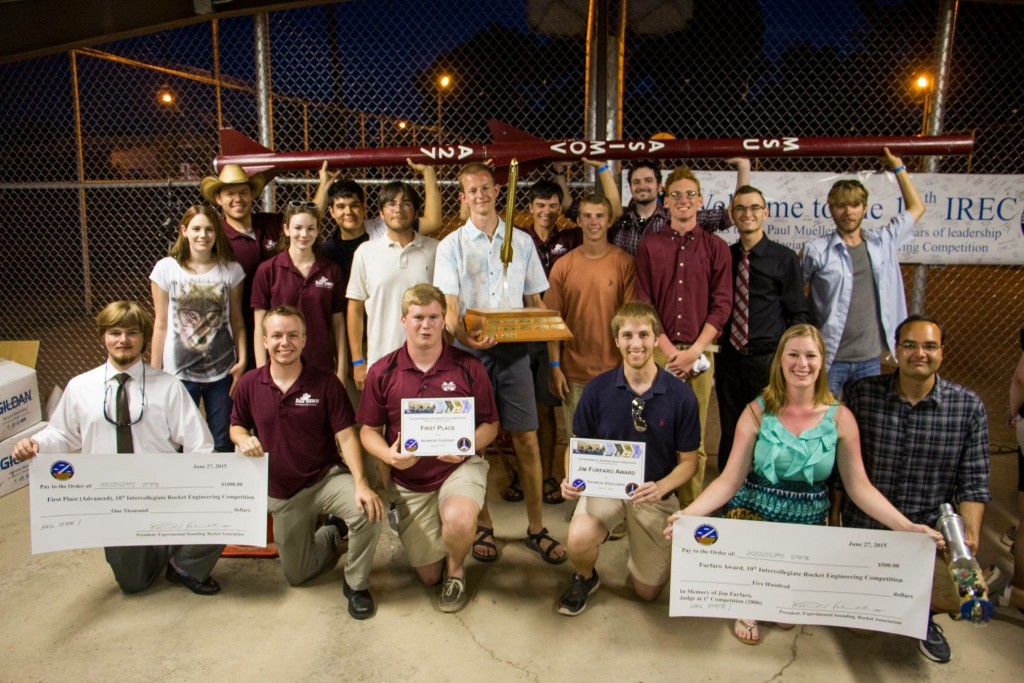Space Cowboys fly to first place in international competition
August 11, 2015
STARKVILLE, Miss. – The Mississippi State rocket team soared high above its opponents at an international collegiate rocket competition.
The Space Cowboys placed first out of 70 universities from seven countries in the Experimental Sounding Rocket Association’s 10th annual Intercollegiate Rocket Engineering Competition in Green River, Utah. The team also won the Jim Furfaro award for overall technical excellence.
The competition challenged teams to build a rocket that could fly to 23,000 feet carrying a payload of 10 pounds. They were judged on rocket design and launch performance as well as technical documents and presentations made throughout the year.
After a perfect launch, the rocket reached 22,562 feet in altitude, earning them the top spot in the competition. The on-board computer data proved that all operations also functioned perfectly and the rocket suffered minimal damage from launch to landing.
“Everyone there was thoroughly impressed with our rocket and how we represented Mississippi State,” chief engineer Eric Stallcup said. “This was a surprising result, but one we are very proud of. We worked hard all year and are excited to be recognized for it.”
As first-time competitors in the IREC, Stallcup says the team’s goal was to have a successful launch and meet the requirements of the competition. The students also said they hoped to represent their college, university and state well by earning an award and placing among the top three teams.
“In the past, we’ve done competitions that weren’t as technically challenging as this one,” Stallcup said. “We really didn’t know if we had a shot at being competitive.”
Since last August, the Space Cowboys have been working to perfect the Asimov rocket, which was named after science fiction author Isaac Asimov. The 13-foot rocket weighs 70 pounds and measures 4 inches in diameter. It is equipped with motors for propulsion, parachutes for safe landing and a payload called “aerospike,” a nosecone that changes shape during the flight to maximize aerodynamic efficiency.
Throughout the 10 months of rocket production and testing, the Space Cowboys faced some of the most difficult challenges since its establishment, including highest altitude goal and perfecting the use of aerospike after limited success in the past. The team also competed against some of the top aerospace universities from around the world, making its victory even sweeter.
“It was an incredible experience seeing all our hard work culminate in the team’s most successful launch ever and to finish ahead of well-known aerospace schools,” structures lead Peter Wetzel said.
During Labor Day weekend, the team plans to visit Kansas, the closest state where the rocket’s full capabilities are approved for testing. While there, they will relaunch Asimov to 30,000 feet and Mach 2, which is twice the speed of sound. The students are also hoping to break the record for the fastest flight of a rocket built by a university team.
Established in 2006, the Space Cowboys is a research and design team supported by the aerospace engineering department and funded by the NASA Space Grant College and Fellowship program. Keith Koenig, an aerospace engineering professor, serves as the faculty adviser and MSU alumnus Cody Hardin serves as the industry adviser.
Team members by hometown:
AJMER, India – Daksh Shukla, a graduate student in aerospace engineering, is the leader of the aerospike subteam.
ATHENS, Greece – Bill Sassanis, a graduate student in aerospace engineering, is a member of the aerospike subteam.
CAPE CANAVERAL, Fla. – Augustus “Gus” Buonviri, a sophomore aerospace engineering major, is a member of the propulsion subteam.
GULFPORT, Miss. – Daniel Mazariegos, a sophomore aerospace major, is a member of the structures subteam. Gregory Samms, a freshman in aerospace engineering, is a member of the propulsion subteam. Jessica Swann, a freshman in aerospace engineering, is a member of the structures subteam.
HAMILTON, Miss. – Justin Taylor, a sophomore in aerospace engineering, is a member of the structures subteam.
HUNTSVILLE, Ala. – Eric Stallcup, a junior in aerospace engineering, is the chief engineer for the Space Cowboys. Michael Spence, a sophomore in aerospace engineering, is a member of the propulsion subteam.
JACKSON, Miss. – Reed Clay, a sophomore in aerospace engineering, is a member of the propulsion subteam.
KENNETT, Mo. – George Hrissikos, a freshman aerospace engineering major, is a member of the aerospike subteam.
LAUREL, Miss. – Jacob Stephens, a sophomore in aerospace engineering, is the leader of the propulsion subteam.
LILLIAN, Ala. – Jacob Frady, a sophomore in aerospace engineering, is a member of the propulsion subteam.
MADISON, Ala. – Peter Wetzel, a junior in aerospace engineering, is the leader of the structures subteam.
MANDEVILLE, La. – Rebecca Oppenheim, a freshman aerospace engineering major, is a member of the structures subteam.
OLIVE BRANCH, Miss. – Hunter Gatlin, a sophomore political science major, is a member of the structures subteam.
ORANGE BEACH, Ala. – Amy Sanford, a junior in aerospace engineering, is the project manager of Space Cowboys.
PENSACOLA, Fla. – Johnie Sublett, a sophomore in aerospace engineering, is the leader of the electronics subteam.
POPLARVILLE, Miss. – Torrey Harriel, a graduate student in aerospace engineering, is the Webmaster for the team and assists with the recovery and aerospike subteams.
RIDGELAND, Miss. – Sean Murray, a freshman aerospace engineering major, is a member of the propulsion subteam.
SLIDELL, La. – Nicholas Tymkiw, a freshman aerospace engineering major, is a member of the propulsion subteam.
The Bagley College of Engineering is online at www.bagley.msstate.edu.
By: Erin Boozer Zimmer

